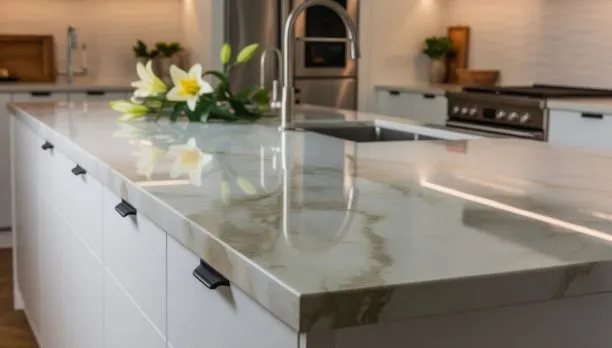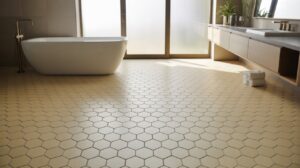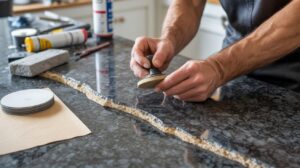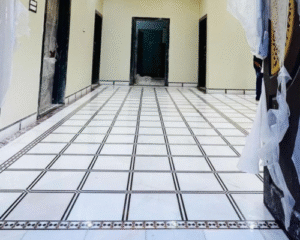What is faux marble? At SF Marble and Granite Inc., we define it as a crafted surface designed to replicate the elegant look of real marble at a fraction of the cost. It can be made from materials like laminate, resin, or painted finishes, offering a wide range of colors and patterns that closely resemble natural stone. This makes it an attractive option for homeowners who want marble’s beauty without the high price tag or intensive maintenance.
Many people today are turning to faux marble because it blends style, durability, and affordability. While real marble is a natural stone with unique veining formed over millions of years, faux marble is manufactured using modern techniques that allow for greater design flexibility. This means you can achieve the same sophisticated look in kitchens, bathrooms, and furniture while enjoying easier upkeep and a more budget-friendly investment.
Table of Contents
ToggleWhat is Faux Marble?

What is faux marble? It’s a manufactured surface designed to look like natural marble but made using alternative materials. At SF Marble and Granite, we often recommend it to clients who want the luxurious appeal of marble without the high cost or maintenance. This versatile option can be used for countertops, flooring, wall panels, and furniture, offering beauty and practicality in one package.
Common Materials Used in Faux Marble:
- Paint Finish – Creates a marble-like pattern on walls or furniture.
- Marble Laminate – A thin sheet with a marble design bonded to a base.
- Resin & Epoxy – Durable options for a seamless faux marble slab look.
- Ceramic or Porcelain Tile – Printed with marble-style veining.
- Quartz-Based Surfaces – Engineered stone like quartz countertops with marble-inspired patterns.
Faux marble provides flexibility both in terms of design and budget, making it an excellent option for modern homes and commercial spaces alike. Whether you choose a painted wall finish, sleek marble laminate, or a solid faux marble slab, you can achieve the timeless charm of marble with fewer limitations and more customization options.
History and Evolution of Faux Marble
When people ask what faux marble is, the answer goes beyond modern home decor; it has a history that spans centuries. Ancient architecture provided some of the earliest examples, where artisans used painting techniques to recreate the luxurious appearance of real marble palaces and temples with faux marbling techniques. Not only was this method beautiful, but also cost-efficient compared to quarrying heavy stones for use in construction projects.
Key Stages in the Evolution of Faux Marble:
- Ancient Rome & Greece – Craftsmen painted columns and walls to resemble marble, often paired with mosaic floor designs.
- Renaissance Europe – Artists perfected faux marble painting for churches and palaces, combining it with tile bathroom accents for elegance.
- Industrial Revolution – Advances in materials led to the creation of early artificial marble countertops and architectural elements.
- Modern Era – Today’s faux marble benefits from precision printing, durable coatings, and improved sealing marble techniques to enhance longevity.
Faux marble has transformed over time from hand-painted artistry into engineered materials that closely emulate its depth, texture, and veining of natural stone with precision. Be it museum restoration work or modern countertops featuring artificial marble surfaces, faux marble’s influence continues to thrive in both traditional and contemporary environments alike.
Types of Faux Marble
When exploring what faux marble is, it’s important to know the different forms it can take. Modern faux marble is available in several variations, each designed for specific uses, from wall finishes to countertops. Whether you’re aiming for the elegance of luxurious marble or the cool tones of grey marble, there’s a style to fit your home’s personality and budget.
Popular Types of Faux Marble:
- Faux Marble Paint Finish – Applied directly to walls or furniture, this creates the visual depth of natural stone without heavy materials.
- Faux Marble Laminate – Ideal for countertops, cabinetry, or even laminate flooring, offering durability with a marble-like appearance.
- Faux Marble Resin & Epoxy – Great for seamless floors and decorative surfaces, providing both strength and high-end looks.
- Faux Marble Tile – Perfect for kitchen backsplashes or grey marble-inspired tile bathroom designs.
From decorative furniture to expansive flooring projects, faux marble offers incredible versatility. It gives you the timeless appeal of luxurious marble while allowing more freedom in design and installation. Whether it’s a painted accent wall, a sleek faux marble countertop, or a stylish set of floor tiles, these options prove that beauty and practicality can go hand in hand.
How Faux Marble is Made
Understanding what faux marble is also means knowing how it’s created. Depending on the style painted, laminate, or resin, the process can vary, but the goal is always to replicate the natural beauty of stone, such as Greek Thassos marble, while offering more affordability and design flexibility. From decorative wall panels to durable floor finishes, the craftsmanship behind faux marble ensures realistic textures and patterns.
Step-by-Step Creation Methods:
- Painted Faux Marble – Skilled artists layer paint over a prepared surface, using sponges, feathers, and fine brushes to create veining patterns similar to Greek Thassos or other natural stones.
- Laminate Faux Marble – A printed marble design is applied to a sheet of laminate, then bonded to surfaces like countertops, cabinets, or even a checkerboard–patterned base.
- Resin & Epoxy Faux Marble – Pigments are mixed into resin or epoxy and poured over a base, creating a seamless surface perfect for walls, furniture, or even concrete floor overlays.
The differences between these types come down to texture, finish, and realism. Painted finishes often have a subtle matte look, laminate offers a smooth and uniform feel, and resin or epoxy provides a glossy, glass-like surface. By choosing the right type of faux marble, homeowners can match their desired style, whether it’s a sleek modern gloss or a classic checkerboard marble effect.
Faux Marble vs Real Marble
When learning what faux marble is, it’s essential to compare it with real marble to decide which suits your space best. While genuine marble is a natural stone formed over thousands of years, faux marble is crafted through stone fabrication techniques that replicate its beauty at a lower cost. Each has its advantages depending on your budget, style preferences, and maintenance expectations.
Key Differences Between Faux Marble and Real Marble:
- Durability – Real marble is strong but prone to scratching and staining without proper care, while faux marble can be more resistant to daily wear in high-traffic areas.
- Cost – Faux marble is significantly more affordable, making it ideal for larger projects like flooring or sink installation Lowell kitchens.
- Maintenance – Real marble requires frequent sealing to stay looking its best, whereas faux marble is easier to clean marble surfaces minimal upkeep.
- Appearance & Authenticity – Real marble offers unique, natural veining, while high-quality faux marble can look almost identical but lacks the same depth and rarity.
In the end, the choice depends on your priorities. If you value authenticity and the prestige of natural stone, real marble is unmatched. But if you want the elegance of marble with easier upkeep and a lower price point, faux marble offers a smart, stylish alternative, especially for busy homes and commercial projects like sink installation, Lowell kitchens, and bathrooms.
How to Choose Quality Faux Marble
If you’ve been curious about faux marble and are considering it for your home, knowing how to select the appropriate quality product is of utmost importance. Not all faux marble products offer realistic veining or last as long; some offer greater realism, while others may wear quickly or look flat. Whether you’re selecting material for countertops, wall panels, or marble floor installation, paying attention to detail will ensure your investment lasts.
What to Look for in Quality Faux Marble:
- Realistic Veining & Texture – Look for patterns that mimic natural marble without appearing repetitive or overly printed.
- Durable Surface Finish – Choose products with scratch and stain resistance, especially for high-traffic areas.
- Color Depth – Quality faux marble should have layered colors that give it a natural, stone-like depth.
- Proper Sizing & Thickness – Thicker slabs or tiles often last longer and look more authentic.
- Trusted Supplier or Fabricator – Work with experienced companies that can provide samples and demonstrate past projects.
Selecting quality faux marble is more than about looks; it is also about performance. A well-made surface will not only enhance the beauty of your home but also withstand daily use. By choosing realistic veining and solid construction from reliable suppliers, faux marble offers the elegance and beauty of natural stone without all of its challenges and costs – perfect for sleek countertops and professional floor installations alike!
Final Thought
What is faux marble? It’s a practical yet elegant choice for homeowners who want the beauty of natural stone without the high cost or upkeep. At SF Marble and Granite Inc., we’ve seen how faux marble can completely transform kitchens, bathrooms, and living spaces, offering realistic veining, versatile styles, and long-lasting performance for a fraction of the price of real marble.
If you’re ready to upgrade your home, now is the perfect time to explore faux marble for countertops, walls, or flooring. Contact SF Marble and Granite Inc. today to discover our wide range of options and let our experts help you create a stunning, functional space you’ll enjoy for years to come.
FAQs
Is faux marble durable for kitchen countertops?
Yes, high-quality faux marble can be very durable for kitchen use, especially if you choose laminate, resin, or quartz-based options. These materials resist stains and scratches better than natural marble, making them ideal for busy kitchens.
How do you clean and maintain faux marble?
Faux marble is easy to maintain; just use a mild soap and a soft cloth for regular cleaning. Avoid abrasive cleaners or scouring pads, as they can dull the surface over time. With minimal care, your faux marble can look beautiful for years.
Can faux marble look as real as natural marble?
Absolutely. Modern manufacturing techniques create incredibly realistic veining, depth, and texture. Many faux marble surfaces are nearly indistinguishable from real marble, especially when installed by professionals like SF Marble and Granite Inc.







